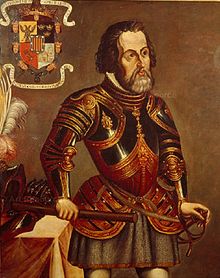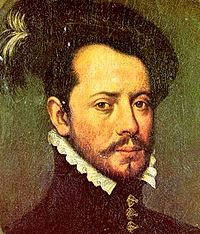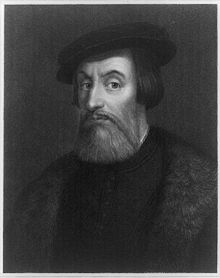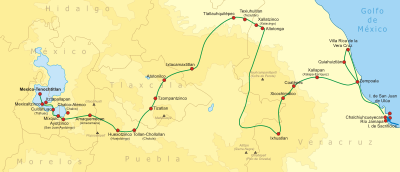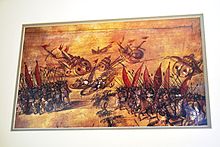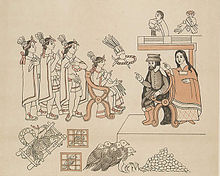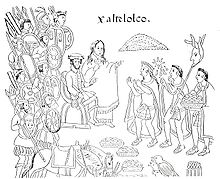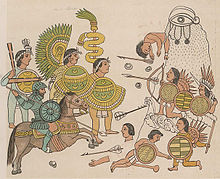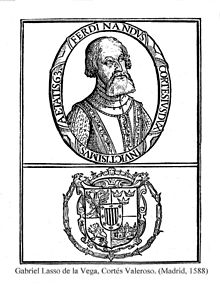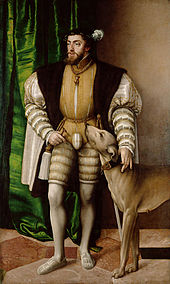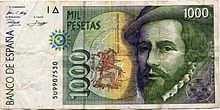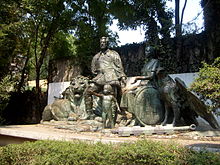
Hernán Cortés
Did you know...
This Wikipedia selection is available offline from SOS Children for distribution in the developing world. To compare sponsorship charities this is the best sponsorship link.
Hernán Cortés de Monroy y Pizarro, 1st Marquis of the Valley of Oaxaca (Spanish pronunciation: [erˈnaŋ korˈtes de monˈroj i piˈθaro]; 1485 – December 2, 1547) was a Spanish Conquistador who led an expedition that caused the fall of the Aztec Empire and brought large portions of mainland Mexico under the rule of the King of Castile in the early 16th century. Cortés was part of the generation of Spanish colonizers that began the first phase of the Spanish colonization of the Americas.
Born in Medellín, Spain, to a family of lesser nobility, Cortés chose to pursue a livelihood in the New World. He went to Hispaniola and later to Cuba, where he received an encomienda and, for a short time, became alcalde (magistrate) of the second Spanish town founded on the island. In 1519, he was elected captain of the third expedition to the mainland, an expedition which he partly funded. His enmity with the Governor of Cuba, Diego Velázquez de Cuéllar, resulted in the recall of the expedition at the last moment, an order which Cortés ignored. Arriving on the continent, Cortés executed a successful strategy of allying with some indigenous people against others. He also used a native woman, Doña Marina, as an interpreter; she would later bear Cortés a son. When the Governor of Cuba sent emissaries to arrest Cortés, he fought them and won, using the extra troops as reinforcements. Cortés wrote letters directly to the king asking to be acknowledged for his successes instead of punished for mutiny. After he overthrew the Aztec Empire, Cortés was awarded the title of Marqués del Valle de Oaxaca, while the more prestigious title of Viceroy was given to a high-ranking nobleman, Antonio de Mendoza. In 1541 Cortés returned to Spain, where he died peacefully but embittered, six years later.
Because of the controversial undertakings of Cortés and the scarcity of reliable sources of information about him, it has become difficult to assert anything definitive about his personality and motivations. Early lionizing of the conquistadors did not encourage deep examination of Cortés. Later reconsideration of the conquistadors' character in the context of modern anti-colonial sentiment also did little to expand understanding of Cortés as an individual. As a result of these historical trends, descriptions of Cortés tend to be simplistic, and either damning or idealizing.
Name
While he is often now referred to as Hernán or Hernando Cortés (IPA: [korˈteθ]), in his time he called himself Hernando or Fernando Cortés ( [korˈtes]). The names Hernán, Hernando and Fernando are all equally correct. The latter two were most commonly used during his lifetime, but the former shortened form has become common in both the Spanish and English languages in modern times, and is the name by which many people know him today. Although his paternal surname is sometimes spelled in the Anglo-Saxon world with a final "z" as Cortéz, this is incorrect. Cortéz is a Spanish surname but in Castillean Spanish the letters z and s represent different sounds, and the names also have different etymologies. Cortés' family was distinct from the families using the spelling with z, and he did not use this spelling.
Early life
Cortés was born in 1485 in the town of Medellín, in modern day Extremadura, Spain. His father, Martín Cortés de Monroy, born in 1449 to Rodrigo or Ruy Fernández de Monroy and his wife María Cortés, was an infantry captain of distinguished ancestry but slender means. Hernán's mother was Catalina Pizarro Altamirano. Through his mother, Hernán was the second cousin once removed of Francisco Pizarro, who later conquered the Inca Empire of modern-day Peru (not to be confused with another Francisco Pizarro who joined Cortés to conquer the Aztecs), through her parents Diego Altamirano and wife and cousin Leonor Sánchez Pizarro Altamirano, first cousin of Pizarro's father. Through his father, Hernán was a twice distant relative of Nicolás de Ovando, the third Governor of Hispaniola. His paternal grandfather was a son of Rodrigo de Monroy y Almaraz, 5th Lord of Monroy, and wife Mencía de Orellana y Carvajal.
Hernán Cortés is described as a pale, sickly child by his biographer, chaplain, and friend Francisco López de Gómara. At the age of 14, Cortés was sent to study at the University of Salamanca in west-central Spain. This was Spain's great centre of learning, and while accounts vary as to the nature of Cortés's studies, his later writings and actions suggest he studied Law and probably Latin.
After two years, Cortés, tired of schooling, returned home to Medellín, much to the irritation of his parents, who had hoped to see him equipped for a profitable legal career. However, those two years at Salamanca, plus his long period of training and experience as a notary, first in Seville and later in Hispaniola, would give him a close acquaintance with the legal codes of Castile that helped him to justify his unauthorized conquest of Mexico.
At this point in his life, Cortés was described by Gómara as restless, haughty and mischievous. This was probably a fair description of a 16-year-old boy who had returned home only to find himself frustrated by life in his small provincial town. By this time, news of the exciting discoveries of Christopher Columbus in the New World was streaming back to Spain.
Departure for the New World
Plans were made for Cortés to sail to the Americas with a family acquaintance and distant relative, Nicolás de Ovando, the newly appointed governor of Hispaniola (currently Haiti and the Dominican Republic), but an injury he sustained while hurriedly escaping from the bedroom of a married woman from Medellín prevented him from making the journey. Instead, he spent the next year wandering the country, probably spending most of his time in the heady atmosphere of Spain's southern ports of Cadiz, Palos, Sanlucar, and Seville, listening to the tales of those returning from the Indies, who told of discovery and conquest, gold, Indians, and strange unknown lands. He finally left for Hispaniola in 1504 where he became a colonist.
Arrival
Cortés reached Hispaniola in a ship commanded by Alonso Quintero, who tried to deceive his superiors and reach the New World before them in order to secure personal advantages. Quintero's mutinous conduct may have served as a model for Cortés in his subsequent career. The history of the conquistadores is rife with accounts of rivalry, jockeying for positions, mutiny, and betrayal.
Upon his arrival in 1504 in Santo Domingo, the capital of Hispaniola, the 18-year-old Cortés registered as a citizen, which entitled him to a building plot and land to farm. Soon afterwards, Nicolás de Ovando, still the governor, gave him an encomienda and made him a notary of the town of Azua de Compostela. His next five years seemed to help establish him in the colony; in 1506, Cortés took part in the conquest of Hispaniola and Cuba, receiving a large estate of land and Indian slaves for his efforts from the leader of the expedition.
Cuba
In 1511, Cortés accompanied Diego Velázquez de Cuéllar, an aide of the Governor of Hispaniola, in his expedition to conquer Cuba. Velázquez was appointed as governor. At the age of 26, Cortés was made clerk to the treasurer with the responsibility of ensuring that the Crown received the quinto, or customary one-fifth of the profits from the expedition.
The Governor of Cuba, Diego Velázquez, was so impressed with Cortés that he secured a high political position for him in the colony. He became secretary for Governor Velázquez. Cortés was twice appointed municipal magistrate ( alcalde) of Santiago. In Cuba, Cortés became a man of substance with an encomienda to provide Indian labor for his mines and cattle. This new position of power also made him the new source of leadership, which opposing forces in the colony could then turn to. In 1514, Cortés led a group which demanded that more Indians be assigned to the settlers.
As time went on, relations between Cortés and Governor Velázquez became strained. This all began once news of Juan de Grijalva, establishing a colony on the mainland where there was a bonanza of silver and gold, reached Velázquez; it was decided to send him help. Cortés was appointed Captain-General of this new expedition in October 1518, but was advised to move fast before Velázquez changed his mind. With Cortés's experience as an administrator, knowledge gained from many failed expeditions, and his impeccable rhetoric he was able to gather six ships and 300 men, within a month. Predictably, Velázquez's jealousy exploded and decided to place the leadership of the expedition in other hands. However, Cortés quickly gathered more men and ships in other Cuban ports.
Cortés also found time to become romantically involved with Catalina Xuárez (or Juárez), the sister-in-law of Governor Velázquez. Part of Velázquez's displeasure seems to have been based on a belief that Cortés was trifling with Catalina's affections. Cortés was temporarily distracted by one of Catalina's sisters but finally married Catalina, reluctantly, under pressure from Governor Velázquez. However, by doing so, he hoped to secure the good will of both her family and that of Velázquez.
It was not until he had been almost 15 years in the Indies, that Cortés began to look beyond his substantial status as mayor of the capital of Cuba and as a man of affairs in the thriving colony. He missed the first two expeditions, under the orders of Francisco Hernández de Córdoba and then Juan de Grijalva, sent by Diego Velázquez to Mexico in 1518.
Conquest of Mexico
In 1518 Velázquez put him in command of an expedition to explore and secure the interior of Mexico for colonization. At the last minute, due to the old gripe between Velázquez and Cortés, he changed his mind and revoked his charter. Cortés ignored the orders and went ahead anyway, in February 1519, in an act of open mutiny. Accompanied by about 11 ships, 500 men, 13 horses and a small number of cannons, he landed in the Yucatan Peninsula in Mayan territory. There, he encountered Geronimo de Aguilar, a Spanish Franciscan priest who had survived a shipwreck a period in captivity of the local Maya before escaping. Aguilar, had learned the Chontal Maya language during his captivity, and could thus translate for Cortés. In March 1519, Cortés formally claimed the land for the Spanish crown. He stopped in Trinidad to hire more soldiers and obtain more horses. Then he proceeded to Tabasco, where he met with resistance and won a battle against the natives. He received twenty young indigenous women from the vanquished natives and he converted them all to Christianity. Among these women was La Malinche, his future mistress and mother of his child Martín. Malinche knew both the Nahuatl language and Chontal Maya, thus enabling Cortés to communicate with the Aztecs via Aguilar. Through La Malinche, Cortés learned from the Tabascans about the wealthy Aztec Empire.
In July 1519, his men took over Veracruz: by this act, Cortés dismissed the authority of the Governor of Cuba to place himself directly under the orders of Charles V. In order to eliminate any ideas of retreat, Cortés scuttled his ships. In Veracruz, he met some of the tributaries of the Aztecs and asked them to arrange a meeting with Moctezuma II, the tlatoani (ruler) of the Aztec Empire. Moctezuma repeatedly turned down the meeting, but Cortés was determined. Leaving a hundred men in Veracruz, Cortès marched on Tenochtitlan in mid-August 1519, along with 600 men, 15 horsemen, 15 cannons, and hundreds of indigenous carriers and warriors. On the way to Tenochtitlan, Cortés made alliances with indigenous peoples such as the Nahuas of Tlaxcala, the Tlaxcaltec, who had surrounded the Spanish and about 2,000 porters on a hilltop and the Totonacs of Cempoala. In October 1519, Cortés and his men, accompanied by about 3,000 Tlaxcalteca, marched to Cholula, the second largest city in central Mexico. Cortés, either in a pre-meditated effort to instill fear upon the Aztecs waiting for him at Tenochtitlan or (as he later claimed when under investigation) wishing to make an example when he feared native treachery, massacred thousands of unarmed members of the nobility gathered at the central plaza, then partially burned the city.
By the time he arrived in Tenochtitlan the Spaniards had a large army. On November 8, 1519, they were peacefully received by Moctezuma II. Moctezuma deliberately let Cortés enter the Aztec capital, the island city of Tenochtitlan, hoping to get to know their weaknesses better and to crush them later. He gave lavish gifts in gold to the Spaniards which, rather than placating them, excited their ambitions for plunder. In his letters to Charles V, Cortés claimed to have learned at this point that he was considered by the Aztecs to be either an emissary of the feathered serpent god Quetzalcoatl or Quetzalcoatl himself — a belief which has been contested by a few modern historians. But quickly Cortès learned that several Spaniards on the coast had been killed by Aztecs while supporting the Totonacs, and decided to take Moctezuma as a hostage in his own palace, indirectly ruling Tenochtitlan through him.
Meanwhile, Velasquez sent another expedition, led by Pánfilo de Narváez, to oppose Cortés, arriving in Mexico in April 1520 with 1,100 men. Cortés left 200 men in Tenochtitlan and took the rest to confront Narvaez. He overcame Narváez, despite his numerical inferiority, and convinced the rest of Narvaez's men to join him. In Mexico, one of Cortés's lieutenants Pedro de Alvarado, committed The massacre in the Main Temple, triggering a local rebellion. Cortés speedily returned to Tenochtihlan. On July 1, 1520 Moctezuma was killed (the Spaniards claimed he was stoned to death by his own people; other claim he was murdered by the Spanish once they realized his inability to placate the locals. Faced with a hostile population, Cortés decided to flee for Tlaxcala. During the Noche Triste (30 June-1 July 1520), the Spaniards managed a narrow escape from Tenochtitlan across the Tlacopan causeway, while their backguard was being massacred. Much of the treasure looted by Cortés was lost (as well as his artillery) during this panicked escape from Tenochtitlán. After a battle in Otumba, they managed to reach Tlaxcala, after having lost 870 men. With the assistance of their allies, Cortés's men finally prevailed with reinforcements arriving from Cuba. Cortés began a policy of attrition towards Tenochtitlan, cutting off supplies and subduing the Aztecs' allied cities. The siege of Tenochtitlán ended with Spanish victory and the destruction of the city.
In January 1521, Cortés countered a conspiracy against him, headed by Antonio de Villafana, who was hanged for the offense. Finally, with the capture of Cuauhtémoc, the Tlatoani (ruler) of Tenochtitlán, on 13 August 1521, the Aztec Empire disappeared, and Cortés was able to claim it for Spain, thus renaming the city Mexico City. From 1521 to 1524, Cortés personally governed Mexico.
Appointment to governorship of Mexico and internal dissensions
Many historical sources have conveyed an impression that Cortés was unjustly treated by the Spanish Crown, and that he received nothing but ingratitude for his role in establishing New Spain. This picture is the one Cortés presents in his letters and in the later biography written by Gomara. However, there may be more to the picture than this. Cortés's own greed and vanity may have played a part in his deteriorating position with the king
- "Cortés personally was not ungenerously rewarded, but he speedily complained of insufficient compensation to himself and his comrades. Thinking himself beyond reach of restraint, he disobeyed many of the orders of the Crown, and, what was more imprudent, said so in a letter to the emperor, dated October 15, 1524 (Ycazbalceta, "Documentos para la Historia de México", Mexico, 1858, I). In this letter Cortés, besides recalling in a rather abrupt manner that the conquest of Mexico was due to him alone, deliberately acknowledges his disobedience in terms which could not fail to create a most unfavourable impression."
King Charles I of Spain, who had become Holy Roman Emperor Charles V in 1519, appointed Cortés as governor, captain general and chief justice of the newly conquered territory, dubbed " New Spain of the Ocean Sea". But also, much to the dismay of Cortés, four royal officials were appointed at the same time to assist him in his governing — in effect submitting him to close observation and administration. Cortés initiated the construction of Mexico City, destroying Aztec temples and buildings and then rebuilding on the Aztec ruins what soon became the most important European city in the Americas. Cortés managed the founding of new cities and appointed men to extend Spanish rule to all of New Spain, imposing the encomienda land tenure system in 1524. He also supported efforts to evangelize the indigenous people to Christianity and sponsored new explorations. He then spent the next seven years establishing peace among the Indians of Mexico and developing mines and farmlands. Cortés was one of the first Spaniards to attempt to grow sugar in Mexico and one of the first to import African slaves to early colonial Mexico. At the time of his death his estate contained at least 200 slaves who were either native Africans or of African descent.
In 1523, the Crown (possibly influenced by Cortés's enemy, Bishop Fonseca), sent a military force under the command of Francisco de Garay to conquer and settle the northern part of Mexico, the region of Pánuco. This was another setback for Cortés who mentioned this in his fourth letter to the King in which he describes himself as the victim of a conspiracy by his archenemies Diego Velázquez de Cuéllar, Diego Columbus and Bishop Fonseca as well as Francisco Garay. The influence of Garay was effectively stopped by this appeal to the King who sent out a decree forbidding Garay to interfere in the politics of New Spain, causing him to give up without a fight.
From 1524 to 1526, Cortés headed an expedition to Honduras where he defeated Cristóbal de Olid, who had claimed Honduras as his own under the influence of the Governor of Cuba Diego Velázquez. Fearing that Cuauhtémoc might head an insurrection in Mexico, he brought him with him in Honduras and hanged him during the journey. Raging over Olid's treason, Cortés issued a decree to arrest Velázquez, whom he was sure was behind Olid's treason. This, however, only served to further estrange the Crown of Castile and the Council of Indies, both of which were already beginning to feel anxious about Cortés's rising power.
Cortés's fifth letter to Charles V attempts to justify his conduct, concludes with a bitter attack on "various and powerful rivals and enemies" who have "obscured the eyes of your Majesty." Unfortunately, the Holy Roman Emperor had little time for distant colonies (much of Charles's reign was taken up with wars with France, the German Protestants and the expanding Ottoman Empire), except insofar as they contributed to finance his wars. In 1521, year of the Conquest, Charles V was attending to matters in his German domains and Spain was ruled by Bishop (later Pope) Adrian of Utrecht, who functioned as regent. Velázquez and Fonseca persuaded the regent to appoint a commissioner with powers, (a Juez de residencia, Luis Ponce de León), to investigate Cortés's conduct and even arrest him. Cortés was once quoted as saying that it was "more difficult to contend against (his) own countrymen than against the Aztecs." Governor Diego Velázquez continued to be a thorn in his side, teaming up with Bishop Juan Rodríguez de Fonseca, chief of the Spanish colonial department, to undermine him in the Council of the Indies.
A few days after Cortés's return from his expedition, Ponce de León suspended Cortés from his office of governor of New Spain. The Licentiate then fell ill and died shortly after his arrival, appointing Marcos de Aguilar as alcalde mayor. The aged Aguilar also became sick and appointed Alonso de Estrada governor, who was confirmed in his functions by a royal decree in August 1527. Cortés, suspected of poisoning them, refrained from taking over the government. Estrada sent Diego de Figueroa to the south; but de Figueroa raided graveyards and extorted contributions, meeting his end when the ship carrying these treasures sank. Albornoz persuaded Alonso de Estrada to release Salazar and Chirinos. When Cortés complained angrily after one of his adherent's hand was cut off, Estrada ordered him exiled. Cortés sailed for Spain in 1528 to appeal to Emperor Charles V.
First return to Spain (1528)
In 1528, Cortés returned to Spain to appeal to the justice of his master, Charles V. Juan Altamirano and Alonso Valiente stayed in Mexico and acted as Cortés' representatives during his absence. Cortés presented himself with great splendor before Charles V's court. By this time Charles V had returned and Cortés forthrightly responded to his enemy's charges. Denying he had held back on gold due the crown, he showed that he had contributed more than the quinto (one-fifth) required. Indeed, he had spent lavishly to rebuild Tenochtitlán, damaged during the siege that brought down the Aztec empire.
He was received by Charles with every distinction, and decorated with the order of Santiago. In return for his efforts in expanding the still young Spanish Empire, Cortés was rewarded in 1529 by being named the "Marqués del Valle de Oaxaca" (Marquis of the Oaxaca Valley), a noble title and senorial estate which was passed down to his descendants until 1811. The Oaxaca Valley was one of the wealthiest region of New Spain, and Cortés had 23 000 vassals. Although confirmed in his land holdings and vassals, he was not reinstated as governor and was never again given any important office in the administration of New Spain. During his travel to Spain, his property was mismanaged by abusive colonial administrators. He sided with local natives in a lawsuit. The natives documented the abuses in the Huexotzinco Codex.
Return to Mexico
Cortés returned to Mexico in 1530 with new titles and honours, but with diminished power. Although Cortés still retained military authority and permission to continue his conquests, viceroy Antonio de Mendoza was appointed in 1535 to administer New Spain's civil affairs. This division of power led to continual dissension, and caused the failure of several enterprises in which Cortés was engaged.
On returning to Mexico, Cortés found the country in a state of anarchy. There was a strong suspicion in court circles of an intended rebellion by Cortés, and a charge was brought against him that cast a fatal blight upon his character and plans. He was accused of murdering his first wife. The proceedings of the investigation were kept secret. No report, either exonerating or condemning Cortés, was published. Had the Government declared him innocent, it would have greatly increased his popularity; had it declared him a criminal, a crisis would have been precipitated by the accused and his party. Silence was the only safe policy, but that silence is suggestive that grave danger was feared from his influence.
After reasserting his position and reestablishing some sort of order, Cortés retired to his estates at Cuernavaca, about 30 miles (48 km) south of Mexico City. There he concentrated on the building of his palace and on Pacific exploration. Remaining in Mexico between 1530 and 1541, Cortés quarreled with Nuño Beltrán de Guzmán and disputed the right to explore the territory that is today California with Antonio de Mendoza, the first viceroy. In 1536, Cortés explored the northwestern part of Mexico and discovered the Baja California peninsula. Cortés also spent time exploring the Pacific coast of Mexico. The Gulf of California was originally named the Sea of Cortes by its discoverer Francisco de Ulloa in 1539. This was the last major expedition by Cortés.
Later life and death
Second return to Spain
After his exploration of Baja California, Cortés returned to Spain in 1541, hoping to confound his angry civilians, who had brought many lawsuits against him (for debts, abuse of power, etc.).
On his return he was utterly neglected, and could scarcely obtain an audience. On one occasion he forced his way through a crowd that surrounded the emperor's carriage, and mounted on the footstep. The emperor, astounded at such audacity, demanded of him who he was. "I am a man," replied Cortés proudly, "who has given you more provinces than your ancestors left you cities."
Expedition against Algiers
The emperor finally permitted Cortés to join him and his fleet commanded by Andrea Doria at the great expedition against Algiers in the Barbary Coast in 1541, which was then part of the Ottoman Empire and was used as a base by the famous Turkish corsair Hayreddin Barbarossa who was also the Admiral-in-Chief of the Ottoman Fleet. During this unfortunate campaign, which was his last, Cortés was almost drowned in a storm that hit his fleet while he was pursuing Barbarossa Hayreddin Pasha, who managed to defeat the fleet of Charles V for a second time after the 1538 Battle of Preveza.
Last years and legacy
Having spent a great deal of his own money to finance expeditions, he was now heavily in debt. In February 1544 he made a claim on the royal treasury, but was given a royal runaround for the next three years. Disgusted, he decided to return to Mexico in 1547. When he reached Seville, he was stricken with dysentery. He died in Castilleja de la Cuesta, Seville province, on December 2, 1547, from a case of pleurisy at the age of 62.
Like Columbus, he died a wealthy but embittered man. He left his many mestizo and white children well cared for in his will, along with every one of their mothers. He requested in his will that his remains eventually be buried in Mexico. Before he died he had the Pope remove the "natural" status of three of his children (legitimizing them in the eyes of the church), including Martin, the son he had with Doña Marina (also known as La Malinche), said to be his favourite.
After his death his body has been moved more than eight times for several reasons. On December 4, 1547 he was buried in the mausoleum of the Duke of Medina in the church of San Isidoro del Campo, Sevilla. Three years later (1550) due to the space being required by the duke, his body was moved to the altar of Santa Catarina in the same church. In his testament, Cortés asked for his body to be buried in the monastery he had ordered to be built in Coyoacan in México, ten years after his death, but the monastery was never built. So in 1566, his body was sent to New Spain and buried in the church of "San Francisco de Texcoco", where his mother and one of his sisters were buried.
In 1629, Don Pedro Cortés fourth "Marquez del Valle, his last male descendant, died, so the viceroy decided to move the bones of Cortés along with those of his descendant to the Franciscan church in México. This was delayed for nine years, while his body stayed in the main room of the palace of the viceroy. Eventually it was moved to the Sagrario of Franciscan church, where it stayed for 87 years. In 1716, it was moved to another place in the same church. In 1794, his bones were moved to the " Hospital de Jesus" (founded by Cortés), where a statue by Tolsa and a mausoleum were made. There was a public ceremony and all the churches in the city rang their bells.
In 1823, after the independence of México, it seemed imminent that his body would be desecrated, so the mausoleum was removed, the statue and the coat of arms were sent to Palermo, Sicily, to be protected by the Duke of Terranova. The bones were hidden, and everyone thought that they had been sent out of México. In 1836, his bones were moved to another place in the same building. It was not until 1947 that they were rediscovered thanks to the discovery of a secret document by Lucas Alaman. His body put in charge of the "Instituto Nacional de Antropología e Historia" INAH; it was authenticated and then restored to the same place, this time with a bronze inscription and his coat of arms. In 1981, when a copy of the bust by Tolsa was put in the church, there was a failed attempt to destroy his bones.
Children
Natural children of Hernán Cortés
- doña Catalina Pizarro, born between 1514 and 1515 in Santiago de Cuba or maybe later in Nueva España, daughter of doña Leonor Pizarro, perhaps relative of Cortés.
- don Martín Cortés, born in Coyoacán in 1522, son of doña Marina (La Malinche), called the First Mestizo; about him was written The New World of Martín Cortés; married doña Bernaldina de Porras and had two children:
- doña Ana Cortés
- don Fernando Cortés, Principal Judge of Veracruz. Descendants of this line are alive today in Mexico.
- don Luis Cortés, born in 1525, son of doña Antonia or Elvira Hermosillo.
- doña Leonor Cortés Moctezuma, born in 1527 or 1528 in Ciudad de Mexico, daughter of Aztec princess Tecuichpotzin (baptized Isabel), born in Tenochtitlan on July 11, 1510 and died on July 9, 1550, the eldest legitimate daughter of Moctezuma II Xocoyotzin and wife doña María Miahuaxuchitl; married to Juan de Tolosa, a miner.
- doña María Cortés de Moctezuma, daughter of an Aztec princess; nothing more is known about her except that she probably was born with some deformity.
He married twice: firstly in Cuba to Catalina Juárez Marcaida, who died at Coyoacán in 1522 without issue, and secondly in 1529 to doña Juana Ramírez de Arellano de Zúñiga, daughter of don Carlos Ramírez de Arellano, 2nd Count of Aguilar and wife the Countess doña Juana de Zúñiga, and had:
- don Luis Cortés y Ramírez de Arellano, born in Texcoco in 1530 and died shortly after his birth.
- doña Catalina Cortés de Zúñiga, born in Cuernavaca in 1531 and died shortly after her birth.
- don Martín Cortés y Ramírez de Arellano, 2nd Marquis of the Valley of Oaxaca, born in Cuernavaca in 1532, married at Nalda on February 24, 1548 his twice cousin once removed doña Ana Ramírez de Arellano y Ramírez de Arellano and had issue, currently extinct in male line
- doña María Cortés de Zúñiga, born in Cuernavaca between 1533 and 1536, married to don Luis de Quiñones y Pimentel, 5th Count of Luna
- doña Catalina Cortés de Zúñiga, born in Cuernavaca between 1533 and 1536, died unmarried in Sevilla after the funeral of her father
- doña Juana Cortés de Zúñiga, born in Cuernavaca between 1533 and 1536, married Don Fernando Enríquez de Ribera y Portocarrero, 2nd Duke of Alcalá de los Gazules, 3rd Marquess of Tarifa and 6th Count of Los Molares, and had issue
Disputed interpretation of his life
There are relatively few sources to the early life of Cortés; his fame arose from his participation in the conquest of Mexico and it was only after this that people became interested in reading and writing about him.
Probably the best source is his letters to the king which he wrote during the campaign in Mexico, but they are written with the specific purpose of putting his efforts in a favourable light and so must be read critically. Another main source is the biography written by Cortés's private chaplain Lopez de Gómara, which was written in Spain several years after the conquest. Gómara never set foot in the Americas and knew only what Cortés had told him, and he had an affinity for knightly romantic stories which he incorporated richly in the biography. The third major source is written as a reaction to what its author calls "the lies of Gomara", the eyewitness account written by the Conquistador Bernal Díaz del Castillo does not paint Cortés as a romantic hero but rather tries to emphasize that Cortés's men should also be remembered as important participants in the undertakings in Mexico.
In the years following the conquest more critical accounts of the Spanish arrival in Mexico were written. The Dominican friar Bartolomé de Las Casas wrote his A Short Account of the Destruction of the Indies which raises strong accusations of brutality and heinous violence towards the Indians; accusations against both the conquistadors in general and Cortés in particular. The accounts of the conquest given in the Florentine Codex by the Franciscan Bernardino de Sahagún and his native informants are also less than flattering towards Cortés. The scarcity of these sources has led to a sharp division in the description of Cortés's personality and a tendency to describe him as either a vicious and ruthless person or a noble and honorable cavalier.
Representations in México
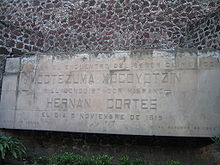
In México there are few representations of Cortés. However, many landmarks still bear his name, from the castle in the city of Cuernavaca to some street names throughout the republic.
The only authentic monuments are in Mexico City at the pass between the volcanoes Iztaccíhuatl and Popocatépetl where Cortés took his soldiers on their march to Mexico City. It is known as the Paso de Cortés.
The muralist Diego Rivera painted several representation of him but the most famous, depicts him as a powerful and ominous figure along with Malinche in a mural in the National Palace in Mexico City.
In 1981, President Lopez Portillo tried to bring Cortés to public recognition. First, he made public a copy of the bust of Cortés made by Manuel Tolsá in the Hospital de Jesús Nazareno with an official ceremony, but soon a nationalist group tried to destroy it, so it had to be taken out of the public. Today the copy of bust is in the "Hospital de Jesús Nazareno" while the original is in Nápoles, Italy, in the Villa Pignatelli.
Later, another monument, known as "Monumento al Mestizaje" by Julián Martínez y M. Maldonado (1982) was commissioned by Lopez Portillo to be put in the "Zocalo" (Main square) of Coyoacan, near the place of his country house, but it had to be removed to a little known park, the Jardín Xicoténcatl, Barrio de San Diego Churubusco. The statue depicts Cortés, Malinche and their son.
There is another statue by Sebastián Aparicio, in Cuernavaca, was in a hotel "El casino de la selva". Cortés is barely recognizable, so it sparked little interest. The hotel was closed to make a commercial center, and the statue was put out of public display by Costco the builder of the commercial centre.
Writings: the Cartas de Relación
Cortés' personal account of the conquest of Mexico is narrated in his five letters addressed to Charles V, the Holy Roman Emperor. These five letters, or cartas de relación, are Cortés' only surviving writings. See "Letters and Dispatches of Cortés", translated by George Folsom (New York, 1843); Prescott's "Conquest of Mexico" (Boston, 1843); and Sir Arthur Helps's "Life of Hernando Cortes" (London, 1871).
As one specialist describes them:
"The Cartas de relación have enjoyed an unequaled popularity among students of the Conquest of Mexico. Cortés was a good writer. His letters to the emperor, on the conquest, deserve to be classed among the best Spanish documents of the period. They are, of course, coloured so as to place his own achievements in relief, but, withal, he keeps within bounds and does not exaggerate, except in matters of Indian civilization and the numbers of population as implied by the size of the settlements. Even there he uses comparatives only, judging from outward appearances and from impressions. Historians, sociologists and political scientists use them to glean information about the Aztec Empire and the clash between the European and Indian cultures. However, as early as the 16th century doubt has been cast on the historicity of these Conquest accounts. It is generally accepted that Cortés does not write a true "history", but rather combines history with fiction. That is to say, in his narrative Cortés manipulates reality in order to achieve his overarching purpose of gaining the favour of the king. Cortés applies the classical rhetorical figure of evidentia as he crafts a powerful narrative full of "vividness" that moves the reader and creates a heightened sense of realism in his letters."
His first letter is lost, and the one from the municipality of Veracruz has to take its place. It was published for the first time in volume IV of "Documentos para la Historia de España", and subsequently reprinted. The first carta de relación is available online at
The Segunda Carta de Relacion, bearing the date of October 30, 1520, appeared in print at Seville in 1522. The "Carta tercera", May 15, 1522, appeared at Seville in 1523. The fourth, October 20, 1524, was printed at Toledo in 1525. The fifth, on the Honduras expedition, is contained in volume IV of the Documentos para la Historia de España. The important letter mentioned in the text has been published under the heading of Carta inédita de Cortés by Ycazbalceta. A great number of minor documents, either by Cortés or others, for or against him, are dispersed through the voluminous collection above cited and through the Colección de Documentos de Indias, as well as in the Documentos para la Historia de México of Ycazbalceta. There are a number of reprints and translations of Cortés's writings into various languages.
Ancestors
|
|
|
|
|
|
|
|
|
|
|
|
|
|
|
|
|
|
|
|
16. Hernán de Monroy y Rodríguez de las Varillas, 4th Lord of Monroy | |||||||||||||||
|
|
||||||||||||||||
|
|
|
|
|
|
||||||||||||
|
|
8. Rodrigo de Monroy y Almaraz, 5th Lord of Monroy |
|
||||||||||||||
|
|
||||||||||||||||
|
|
|
|
|
|
|
|
|
|||||||||
|
|
17. Isabel de Almaraz, Lady of Almaraz | |||||||||||||||
|
|
||||||||||||||||
|
|
|
|
|
|
||||||||||||
|
|
4. Rodrigo or Ruy Fernández de Monroy |
|
||||||||||||||
|
|
||||||||||||||||
|
|
|
|
|
|
|
|
|
|
|
|
||||||
|
|
18. Hernándo Alfonso de Orellana | |||||||||||||||
|
|
||||||||||||||||
|
|
|
|
|
|
||||||||||||
|
|
9. Mencía de Orellana y Carvajal |
|
||||||||||||||
|
|
||||||||||||||||
|
|
|
|
|
|
|
|
|
|||||||||
|
|
19. Juana González de Carvajal | |||||||||||||||
|
|
||||||||||||||||
|
|
|
|
|
|
||||||||||||
|
|
2. Martín Cortés de Monroy |
|
||||||||||||||
|
|
||||||||||||||||
|
|
|
|
|
|
|
|
|
|
|
|
|
|
|
|||
|
|
20. | |||||||||||||||
|
|
||||||||||||||||
|
|
|
|
|
|
||||||||||||
|
|
10. Diego de La Cueva |
|
||||||||||||||
|
|
||||||||||||||||
|
|
|
|
|
|
|
|
|
|||||||||
|
|
21. | |||||||||||||||
|
|
||||||||||||||||
|
|
|
|
|
|
||||||||||||
|
|
5. María Cortés |
|
||||||||||||||
|
|
||||||||||||||||
|
|
|
|
|
|
|
|
|
|
|
|
||||||
|
|
22. | |||||||||||||||
|
|
||||||||||||||||
|
|
|
|
|
|
||||||||||||
|
|
11. María Cortés |
|
||||||||||||||
|
|
||||||||||||||||
|
|
|
|
|
|
|
|
|
|||||||||
|
|
23. | |||||||||||||||
|
|
||||||||||||||||
|
|
|
|
|
|
||||||||||||
|
|
1. Hernán Cortés de Monroy y Pizarro, 1st Marquess of the Valley of Oaxaca |
|
||||||||||||||
|
|
||||||||||||||||
|
|
|
|
|
|
|
|
|
|
|
|
|
|
|
|
|
|
|
|
24. | |||||||||||||||
|
|
||||||||||||||||
|
|
|
|
|
|
||||||||||||
|
|
12. Juan Altamirano |
|
||||||||||||||
|
|
||||||||||||||||
|
|
|
|
|
|
|
|
|
|||||||||
|
|
25. | |||||||||||||||
|
|
||||||||||||||||
|
|
|
|
|
|
||||||||||||
|
|
6. Diego Altamirano |
|
||||||||||||||
|
|
||||||||||||||||
|
|
|
|
|
|
|
|
|
|
|
|
||||||
|
|
26. | |||||||||||||||
|
|
||||||||||||||||
|
|
|
|
|
|
||||||||||||
|
|
13. María de Vivero |
|
||||||||||||||
|
|
||||||||||||||||
|
|
|
|
|
|
|
|
|
|||||||||
|
|
27. | |||||||||||||||
|
|
||||||||||||||||
|
|
|
|
|
|
||||||||||||
|
|
3. Catalina Pizarro Altamirano |
|
||||||||||||||
|
|
||||||||||||||||
|
|
|
|
|
|
|
|
|
|
|
|
|
|
|
|||
|
|
28. Fernando or Hernándo Alonso de Hinojosa | |||||||||||||||
|
|
||||||||||||||||
|
|
|
|
|
|
||||||||||||
|
|
14. Martín Pizarro de Hinojosa |
|
||||||||||||||
|
|
||||||||||||||||
|
|
|
|
|
|
|
|
|
|||||||||
|
|
29. Teresa Martínez Pizarro | |||||||||||||||
|
|
||||||||||||||||
|
|
|
|
|
|
||||||||||||
|
|
7. Leonor Sánchez Pizarro Altamirano |
|
||||||||||||||
|
|
||||||||||||||||
|
|
|
|
|
|
|
|
|
|
|
|
||||||
|
|
30. Benito Hernández Altamirano | |||||||||||||||
|
|
||||||||||||||||
|
|
|
|
|
|
||||||||||||
|
|
15. Isabel Rodríguez Altamirano |
|
||||||||||||||
|
|
||||||||||||||||
|
|
|
|
|
|
|
|
|
|||||||||
|
|
31. Isabel Rodríguez de Aguilar | |||||||||||||||
|
|
||||||||||||||||
|
|
|
|
|
|
||||||||||||
